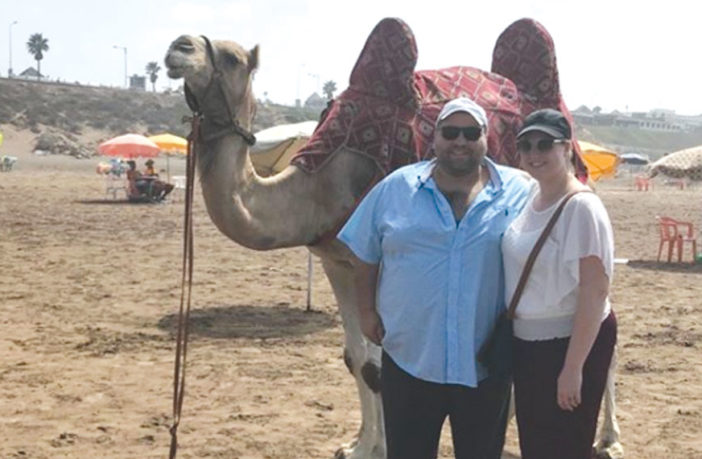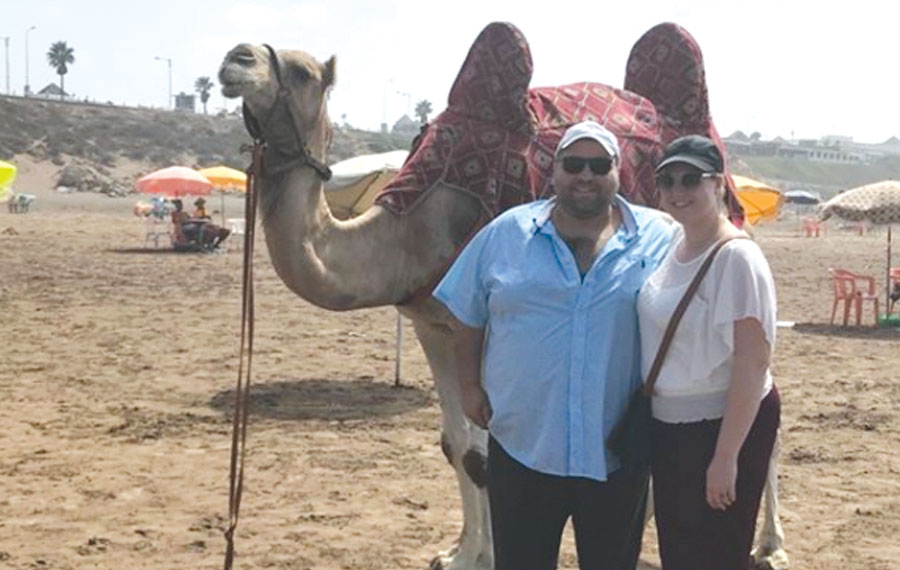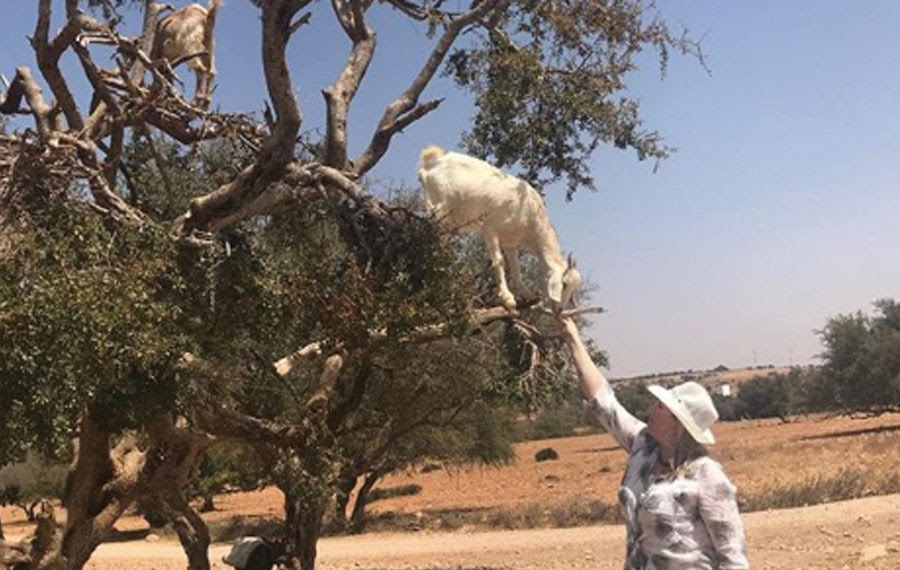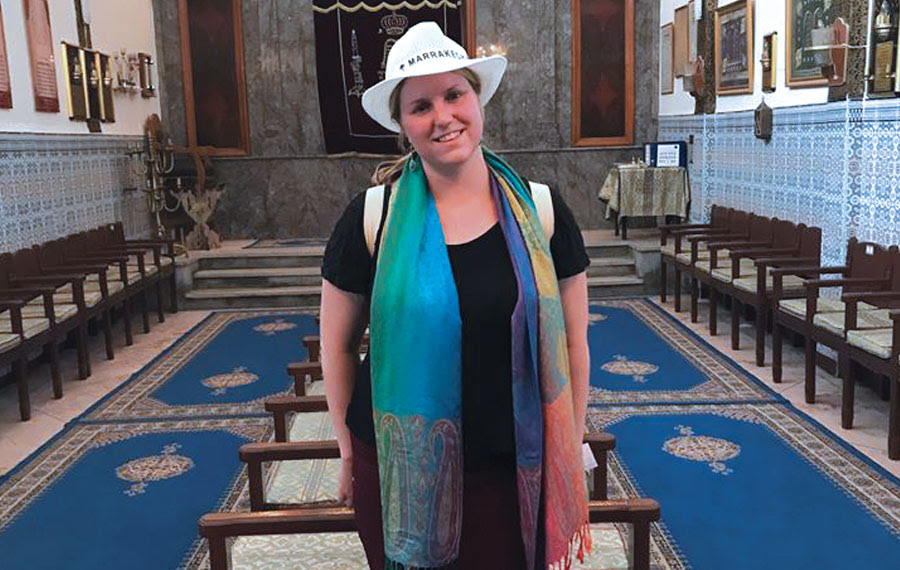Jewish journal
With a camel on the Casablanca beach. Photos by Kylie Ora Lobell and Daniel Lobell
My husband, God bless him, has many crazy ideas. But unlike most people with lofty dreams, he actually follows through with them.
Own a rooster? Check. Have a comedy festival in our backyard? Yup. Reside off a dirt road in Florida for three weeks and live like old people who dine exclusively on buffets and watch “Everybody Loves Raymond” before falling asleep at 9 p.m.? That was us.
So earlier this year, Daniel and I decided we’d go to Morocco after his month long stint performing stand-up at the Edinburgh Fringe Festival in August.
To prepare for our trip, we watched “Casablanca,” (which was filmed in Burbank), and connected with our Moroccan-Jewish friends to learn about life there, including Journal Publisher and Editor-in-Chief David Suissa.
After arriving in Casablanca, we headed to our hotel by the beach, passing Moroccan McDonald’s, Muslim women in head coverings and huge white mansions owned by kings. We went to the beach, where a camel growled at Daniel. We hung out in a hammam — a Turkish bath and steam room. I lasted about five minutes, because being hot and claustrophobic is not my thing.
We visited Rick’s Café, a tourist spot made to look like Rick’s Café Américain from the film “Casablanca,” went to Hassan II Mosque — the second largest mosque in Africa that can hold up to 25,000 worshippers, and hired a tour guide to take us around Jewish Casablanca.
With the Argan tree goats
Although our guide was Muslim, he worked with other Jewish tour guides and knew where to take us. Our first visit was to a small Jewish museum, which contains a shul no longer in use. Then it was on to a kosher bakery in a hidden alleyway to buy treats for Shabbat. We then made our way to Temple Beth-El synagogue, which today is used for special occasions including weddings and bar and bat mitzvahs.
We learned that before the founding of the State of Israel in 1948, Morocco had an estimated 350,000 Jews. Today, there are only a thousand or so who remain in Casablanca. Nonetheless, the city still boasts 22 synagogues, at least four kosher restaurants, 10 kosher butchers and a few bakeries. We went to one of those 22 synagogues at 5 a.m. to say Selichot, and the men (and one woman) there offered us coffee and tea.
Shabbat dinner was spent with a family friend’s cousin, Armand, where we ate his mother-in-law’s tuna casserole and talked with his son about why he didn’t like visiting Los Angeles. “Hollywood Boulevard sucks,” he said. “I agree,” I said.
From Casablanca, we flew to Marrakech, where there are about 500 or so Jews. When we arrived, I immediately noticed three things: How beautiful and colorful it is; how entire families whiz through town on motorbikes; and how old the city felt. When we arrived at our riad (hostel), we realized we were in the old part of town full of tiny, historic alleyways and scores of cats.
“Returning home, I felt incredibly sad. No more culture shock. No more donkeys. No more beautiful lamps and colorful doors and kind, French-speaking cabdrivers.”
Our first stop in Marrakech was the vast, historic souk, Djemaa el-Fna. The indoor section is a huge maze and it’s easy to get lost. We certainly did. Many times. Wares are cheap by American standards and haggling is de rigueur. We quickly purchased a variety of trinkets including a Moroccan tea set, lamps, tagines, pashminas and jewelry. Over the course of the next four days, we returned to the market because it’s impossible to see everything in one day.
We were, however, two of the very few white people in the market, and every few minutes, someone would try to get us to sign up for a tour, buy a souvenir or ask us for money.
We saw the famous performing monkeys on chains, the snake charmers, who apparently sew their snakes’ mouths shut, and a sad owl chained to a cage filled with small squirrels. There were hundreds of chickens in cages, waiting to be slaughtered, and sheep’s heads being roasted on the street. As an animal lover, it was certainly painful to see, but there was nothing I could do except remind myself that I treat my own dogs, chickens and tortoise like family. The sad owl, though, still haunts me.
We took a dirt bike tour of the Marrakech desert. It was bumpy, dusty and magnificent. Our ride took us to a Berber hut, where the family there made us Moroccan tea, and as is custom, tried to pour the tea from the highest height possible.
In the Marrakech synagogue
We also visited Essaouira, a port town about three hours from Marrakech.
I Googled “Jewish Essaouria,” and there was an article about the only Jew — a man named Joseph Sebag, who owned a store called Galérie Aida. It took several attempts with different guides to finally find Sebag and his antiques store. We said, “Shalom” and bought a wood piece from Senegal from him. Sebag ordered us orange juice and offered for us to stay in his flat the next time we were in town.
Other highlights in Marrakech included a meal at the city’s only kosher restaurant, which had a picture of the Rebbe — the late Lubavitcher Rabbi Menachem Mendel Schneerson — on the wall; visiting the graves of tzadikim and meeting the Muslim man whose family has guarded the cemetery for three generations; and purchasing our first shofar, which we blew on Rosh Hashanah.
Returning home, I felt incredibly sad. I was back to reality. No more culture shock. No more donkeys. No more beautiful lamps and colorful doors and kind, French-speaking cabdrivers. Besides Israel, Morocco is the most enchanted place I’ve ever visited. I miss it every day. I understand now why Jews were there for so long, and why there are a few who choose to stay to this day.
We may miss that beautiful magical country, but by golly, we’ll always have Morocco.










